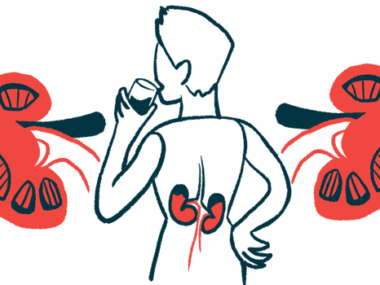Tavneos effective in AAV patients with lung bleeding: Real-world study
Therapy also let all patients reduce their dose of glucocorticoids
Written by |

Tavneos (avacopan) effectively induces disease remission in adults with ANCA-associated vasculitis (AAV) and diffuse alveolar hemorrhage (DAH), that is, bleeding from the small blood vessels in the lungs, according to a real-world study in the U.S.
The therapy also let all patients reduce their dose of glucocorticoids, a standard AAV treatment that may have serious side effects at high doses or with prolonged use.
“Our data support the administration of [Tavneos] and the potential for glucocorticoid sparing in patients with this potentially life-threatening disease manifestation of AAV,” the researchers wrote. “These data can help inform the design of future … trials in AAV.”
The study, “Treatment of Antineutrophil Cytoplasmic Antibody–Associated Vasculitis With Diffuse Alveolar Hemorrhage With Avacopan,” was published in ACR Open Rheumatology.
Tavneos is an oral therapy approved as an add-on to standard medications like glucocorticoids for adults with granulomatosis with polyangiitis (GPA) and microscopic polyangiitis (MPA), the two most common types of AAV. The therapy suppresses the alternative complement pathway, an immune pathway involved in several mechanisms that drive AAV.
Clinical trial data showed Tavneos was better than the glucocorticoid prednisone at promoting long-term remission and improving kidney function in AAV patients, while also showing glucocorticoid-sparing effects.
There’s limited data on Tavneos’ effectiveness with DAH, a severe AAV manifestation marked by lung bleeding caused by damage to the small blood vessels that supply the air sacs where gases are exchanged. Because DAH can progress to breathing failure or even death, effective treatment is crucial to improve outcomes.
“High-dose glucocorticoid therapy has been the only fast-acting remission induction treatment,” the researchers wrote. Glucocorticoids are usually used along with immunosuppressive agents like rituximab (sold as Rituxan, with generics available) and cyclophosphamide, which “take weeks to exert their full effect,” the researchers added. This means it may take a long time before glucocorticoids can be tapered.
Treatment with Tavneos
Here, researchers at the Mayo Clinic reviewed data from 15 AAV patients (eight with GPA, seven with MPA) with DAH who were treated with Tavneos, glucocorticoids, and rituximab and/or cyclophosphamide as an induction treatment. The patients (60% women) were treated at several Mayo clinics between January 2021 and August 2023. They had developed DAH at a median age of 66 and 11 (73.3%) had never smoked.
All the patients received Tavneos at a dose of 30 mg twice daily and methylprednisolone, a glucocorticoid given directly into the bloodstream. Most also received oral prednisone. The way Tavneos was introduced and how prednisone was tapered over time varied widely among them.
Treatment with Tavneos began a median 18 days after receiving the first pulse of intravenous methylprednisolone. Seven patients were started on Tavneos in the hospital within a week of their DAH diagnosis. The remaining eight patients began Tavneos treatment after leaving the hospital, more than two weeks after starting standard induction treatment.
Two patients received no oral glucocorticoids after three doses of intravenous methylprednisolone, while four stopped receiving oral prednisone after four weeks. Others tapered glucocorticoids more slowly.
Over a median follow-up of 17 weeks, or nearly four months, after starting Tavneos, two patients progressed to breathing failure and required oxygen supplementation or ventilation.
“No disease flares or relapses occurred in any of the other 13 patients after starting [Tavneos],” the researchers wrote.
Ten of the 14 patients who were alive at the end of follow-up were in complete remission, which corresponds to no symptoms of AAV and complete discontinuation of prednisone. This was achieved at a median of 52 days (more than 1.5 months) after starting Tavneos. Four others achieved remission (no symptoms) but hadn’t tapered off oral prednisone fully.
This “illustrates that when [Tavneos] is started early, progression of DAH to respiratory failure is unlikely, even when no or very little oral prednisone is given,” the researchers wrote.
Three patients had serious adverse events deemed not directly related to Tavneos: a serious infection in two and kidney failure in the other. One infection was fatal.
Tavneos was discontinued in three patients before completing a year of treatment due to cost reasons (two patients) and a physician’s opinion that it could be stopped (one).
The findings show “most patients achieved remission during follow-up,” wrote the researchers, who said Tavneos was well tolerated. The study, “being the largest observational [study] describing the real-world application of [Tavneos] in patients with AAV and DAH to date, enriches our understanding of the potential and limitations of the administration of this novel agent in this subset of patients with the most acutely life-threatening disease manifestation of AAV.”





